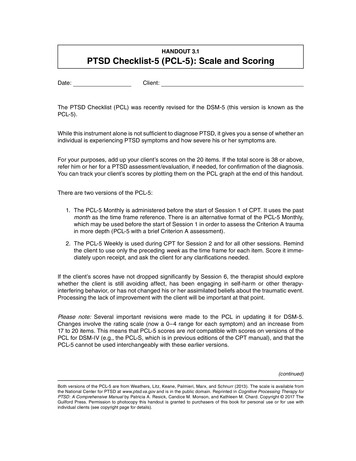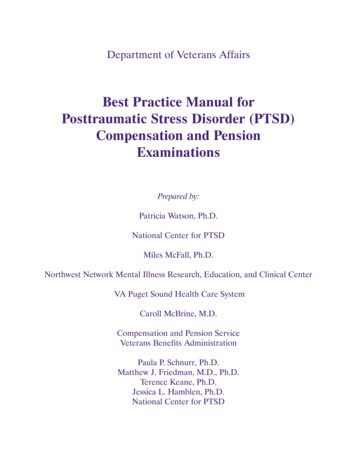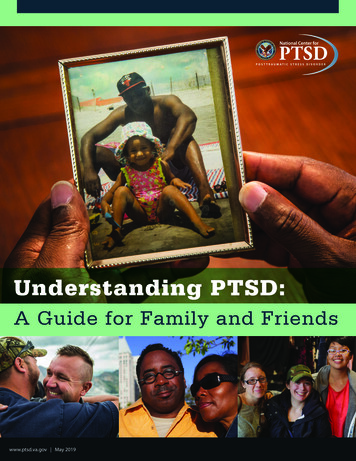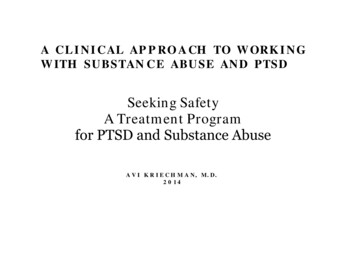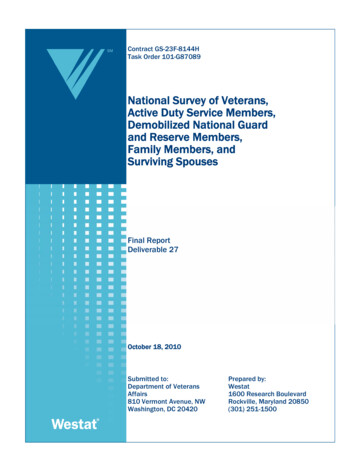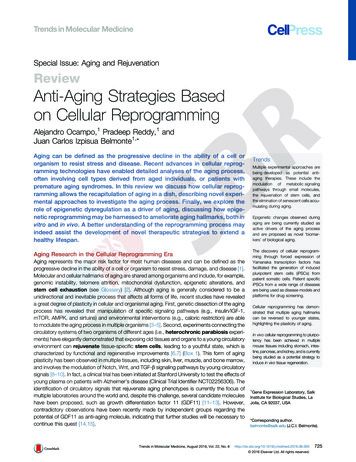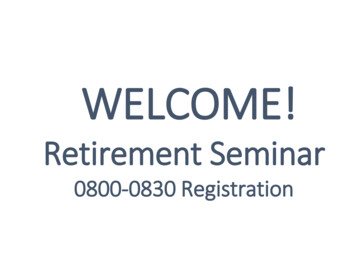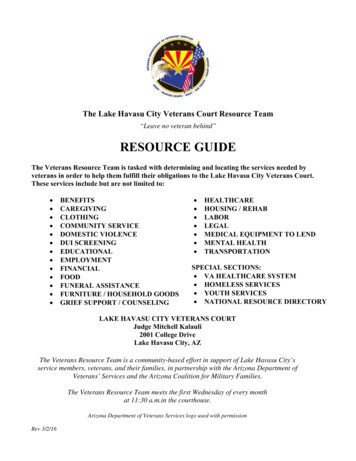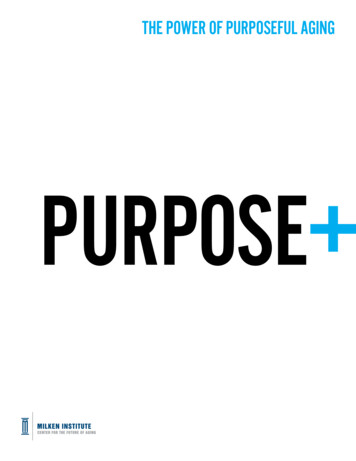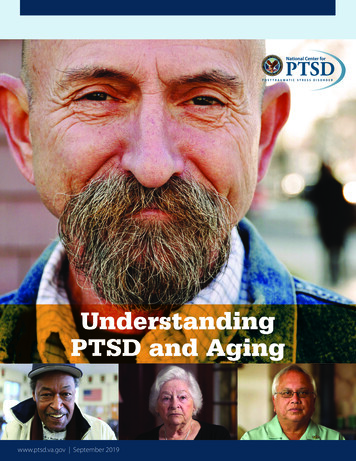
Transcription
UnderstandingPTSD and Agingwww.ptsd.va.gov September 2019
IntroductionOver the years, you may have heard terms like shell shock, combat fatigue, or battle fatigue.Today we use the term posttraumatic stress disorder, or PTSD. PTSD can be a problem foranyone who has gone through or witnessed a traumatic event. It could be an event thathappened long ago or something that has happened recently. Although PTSD is oftenassociated with combat, not all PTSD is combat-related. It can be caused by any experiencethat threatens your life or someone else’s, including sexual trauma or physical abuse.This booklet is written for older adults who have or think they may have PTSD. It is alsofor people who have been diagnosed with PTSD in the past but find their symptomsreoccurring or changing as they age.In the following pages, you’ll learn about PTSD and treatment options, as well as some ofthe challenges you may face later in life as a result of PTSD.Remember, no matter how old you are, it’s never too late to heal from trauma.Table of ContentsWhat is PTSD? . . . . . . . . . . . . . . . . . . . . . . . . . . . . . . . . . . . . . . . . . . . . . . . . . . . . . . . . . . . . . . . . . . 3What Can Cause PTSD? . . . . . . . . . . . . . . . . . . . . . . . . . . . . . . . . . . . . . . . . . . . . . . . . . . . . . . . . . 4PTSD Signs and Symptoms . . . . . . . . . . . . . . . . . . . . . . . . . . . . . . . . . . . . . . . . . . . . . . . . . . . . . . 5How Aging Can Affect PTSD . . . . . . . . . . . . . . . . . . . . . . . . . . . . . . . . . . . . . . . . . . . . . . . . . . . . . 6What to Do if You Have Symptoms of PTSD . . . . . . . . . . . . . . . . . . . . . . . . . . . . . . . . . . . . . . 7Recommended Treatments for PTSD . . . . . . . . . . . . . . . . . . . . . . . . . . . . . . . . . . . . . . . . . . . . 8How Treatment Can Help . . . . . . . . . . . . . . . . . . . . . . . . . . . . . . . . . . . . . . . . . . . . . . . . . . . . . 10Information and Resources . . . . . . . . . . . . . . . . . . . . . . . . . . . . . . . . . . . . . . . . . . . . . . . . . . . 11Information for Family and Friends . . . . . . . . . . . . . . . . . . . . . . . . . . . . . . . . . . . . . . . . . . . . 12To Sum Up . . . . . . . . . . . . . . . . . . . . . . . . . . . . . . . . . . . . . . . . . . . . . . . . . . . . . . . . . . . . . . . . . . . 14Get Help in a Crisis . . . . . . . . . . . . . . . . . . . . . . . . . . . . . . . . . . . . . . . . . . . . . . . . . . . . . . . . . . . 15This booklet is developed by the National Center for PTSD. We are theworld’s leading research and educational center of excellence on PTSDand traumatic stress.2National Center for PTSD Understanding PTSD and Aging
What is PTSD?PTSD is a mental health problem that some people develop after experiencing orwitnessing a life threatening event such as military combat, a natural disaster, a caraccident, or physical or sexual assault.It’s normal to have upsetting memories, feel on edge, or have trouble sleeping after atraumatic event. At first, it may be hard to do everyday activities, like working, attendingcommunity events or religious services, or spending time with the people you care about.But most people start to feel better after a few weeks or months.If it’s been longer than a few months and you’re still having symptoms, you may havePTSD. For some people, PTSD symptoms may appear later on, or come and go over time.Untreated PTSD can last for decades; you can even have PTSD and not know it.Here’s the good news: you can get treatment for PTSD even after many years —and it works.PTSD can come from lots ofdifferent kinds of traumas or events.So, even if it wasn’t the typicalcombat trauma that you think about,you can still have PTSD, and you canstill get treated for PTSD.– Dr. Matt Yoder,VA Clinical Psychologist3
What Can Cause PTSD?Any experience that threatens your life or someone else’s can cause PTSD. These types ofevents are called traumas. Some types of trauma that can cause PTSD include: Combat or other military experiences Learning about the violent or accidental death or injury of a loved one Sexual or physical abuse or assault, at any age Serious accidents, like a car wreck A sudden life-threatening medical event Natural disasters, like a flood, fire, tornado, hurricane, or earthquake Mass violence, like a school shooting or a terrorist attackDuring this kind of event, you may not have any control over what’s happening, and youmay feel afraid, helpless, vulnerable, angry, or even numb. Anyone who has gone througha trauma like this can develop PTSD – even years later.Going through a traumatic event is not rare. At least half of Americans have had atraumatic event in their lives. Of people who have experienced trauma, about 1 in 10 menand 2 in 10 women will develop PTSD. And PTSD can develop at any age.Whether your PTSD is from a recent trauma or from events that happened long ago,treatment can help. The only way to know for sure if you have PTSD is to talk to yourdoctor or health care provider.I never felt like there were Viet Cong in the tree line becauseintellectually, I knew I was home in a safe place. But in my spirit, in myanxiety, I felt like I was always under a sniper’s scope.My life after therapy has been very good. I wanted my old self back. I’vegotten that and more. I’m strong. I’m healthy I’m doing just fine.– Ron WhitcombU.S. Army (1968-1969)4National Center for PTSD Understanding PTSD and Aging
PTSD Signs and SymptomsThere are 4 types of PTSD symptoms, but they may not be exactly the same for everyone.Each person experiences symptoms in their own way.1 . Reliving the event . Unwelcome memories about the trauma can come up at any time,even years after the event. Sometimes they can feel both real and frightening, as if theevent is happening again. This is called a flashback. You may also have nightmares.Memories of the trauma can happen because of a trigger — something that remindsyou of the event. For example, watching a war movie or hearing a helicopter orfireworks may trigger unwanted memories of your time in the service. Seeing a newsreport about a disaster might trigger someone who lived through a hurricane.2 . Avoiding things that remind you of the event . You may try to avoid certain peopleor situations that remind you of the event. For example, you may avoid going out topublic events because it feels too dangerous to be around groups of people. You mayfeel unsafe away from the familiarity of your own home, so traveling becomes difficultor impossible. You may also withdraw from relationships with important people in yourlife because you worry they’ll ask you questions about your past military experience orbecause you feel they just don’t understand what you are going through.3 . Having more negative thoughts and feelings than before . You may feel morenegative than you did before the trauma. You might be sad or numb and lose interestin doing the things you used to enjoy, or things that you might have waited toexperience during retirement. You may feel that the world is dangerous, and you can’ttrust anyone, which can keep you from seeking medical care. It may be hard for you tofeel or express happiness, or other positive emotions.You might also feel guilt or shame about the traumatic event itself, even after manyyears. For example, you may wish you had done more to keep it from happening.4 . Feeling on edge . It’s common to feel jittery or “keyed up”— like it’s hard to relax. Youmight have trouble sleeping or concentrating or feel like you’re always on the lookoutfor danger. You may feel like you have to sit with your back to the wall when you goto a restaurant. You may feel overprotective towards people you love, making it hardto unwind and enjoy time with your children or grandchildren. You may find yousuddenly get angry and irritable at a time in life when you wanted to relax a little more.You may also act in ways that are potentially dangerous, like abusing drugs, drinkingtoo much alcohol, or driving aggressively.5
How Aging Can Affect PTSDSome changes that come with aging can make you feel more vulnerable, and thiscan make your PTSD symptoms more noticeable.Strategies that once seemed to help you avoid thinking about the trauma,like long hours spent at work or self-medicating with alcohol or drugs, may nolonger work. Even positive coping strategies, like exercising or friendships withsupportive peers, can be more difficult to maintain as you get older.Here are some examples of how aging can affect PTSD: 6Self-reflection: You may look back at the course of your life, and unwantedmemories that you had forgotten or purposefully bottled up may return.Retirement: With more time on your hands, unpleasant memories maysurface more often.Loss: The death of a spouse, partner, or friend can mean losing an importantsource of support. This can make you feel alone and unsafe, leaving youvulnerable to PTSD.Physical ability: Because a loss of physical strength often comes with age, youmay feel like you can’t protect yourself.A change in environment: Spending time in unfamiliar or new places, likemoving to a new home or staying at a hotel while on vacation, can upend yourdaily routine and make you feel less safe.Increased screen time: You may be watching more television than you usedto. Media can cause you to relive memories of past traumas. For instance,watching the news or war movies may trigger flashbacks.Medical problems: Hospital stays, chronic illness, and end-of-life issues canmake you feel weaker and more fearful. PTSD symptoms may increase. Thereis research linking PTSD to hypertension and cardiovascular disease, so if youhave PTSD, getting treatment is an important part of managing your health asyou age.National Center for PTSD Understanding PTSD and Aging
But it really wasn’t until after Iretired in 2005 and moved to be withmy family that the symptoms beganto disrupt my life, disrupt my family’slife. I noticed that I was isolating. I’mtypically a gregarious person, hada very active social life, love to takeclasses, whether it’s art or writing orwhatever, and I was doing none of that.– Mary MartinU.S. Air Force (1981-2005)What to Do if You Have Symptoms of PTSD Ask for help . Don’t wait . Talk to your doctor or health care provider about anysymptoms you’re experiencing. Ask for a referral or seek the care of a mentalhealth specialist.If you get your medical care at the VA, you can also get treatment for PTSD there.Every VA offers effective treatments for PTSD.Reach out to your friends and family for support.PTSD treatment works for people of all ages .If you even have an inkling there’s a problem, go find out.There’s help out there for you. And you can turn your lifearound, it’s not too late.”– Jim MoormanU.S. Marine Corps (1963–1971)7
Talking about your trauma is scary. You’vehad a shut closet, and don’t know how muchis going to come out when you open it. Butuntil you address it, you are stuck.– Edward “Terre” DouglasU.S. Air Force (1970-1976)Recommended Treatments for PTSDThere are many types of PTSD treatments that are proven to work. Treatment for PTSD isnot one size fits all. It is important to meet with a medical or mental health care providerand discuss your needs so they can help you find a therapist who is trained in thetreatment that will work best for you.Trauma-focused Talk TherapyTrauma-focused talk therapies are the most effective treatments. They work better thanmedication. Some of these therapies involve thinking or talking about the trauma in a waythat helps people change how they react to their memories. Others focus on challengingnegative or unhelpful thoughts about the trauma.Trauma-focused talk therapies can be intense, but they are safe and effective. Here are themost recommended types of trauma focused talk therapies.CPT (Cognitive Processing Therapy)After a trauma, it is common to have negative thoughts — like thinking what happened isyour fault or that the world is very dangerous. CPT helps you learn to identify and changethese thoughts. Changing how you think about the trauma can help change how you feel.PE (Prolonged Exposure)People with PTSD often try to avoid things that remind them of the trauma. Thiscan help you feel better in the moment, but in the long term it can keep you fromrecovering from PTSD.8National Center for PTSD Understanding PTSD and Aging
In PE, you expose yourself to the thoughts, feelings, and situations that you’ve beenavoiding. It sounds scary, but facing things you’re afraid of in a safe way can help youlearn that you don’t need to avoid reminders of the trauma.EMDR (Eye Movement Desensitization and Reprocessing)People with PTSD react negatively to the memory of their traumas. EMDR can help youprocess these upsetting memories, thoughts, and feelings. You’ll pay attention to thememory while focusing on a back and forth movement until you start to experiencethe memory in a way that’s less upsetting.MedicationAsk your doctor about antidepressants called SSRIs(selective serotonin reuptake inhibitors) and SNRIs(selective norepinephrine reuptake inhibitors), whichare medications that can help raise the level of certainchemicals in your brain so you feel better. Sertraline,paroxetine, and fluoxetine are SSRIs that work for PTSD.Venlafaxine is an SNRI that is effective. Your primary careprovider or a psychiatrist — a doctor who specializes inmental health — can prescribe medication for PTSD.Many Veteranswho come into myoffice wonder if thesetherapies work, andthe short answer is,yes, they work for mostpeople who come inand get the treatments.– Dr. Steven Thorp,Clinical PsychologistIt’s important to know that as you age, changes take place in the way your bodyhandles medications. Be sure to discuss all of your medications with your healthcare provider.A warning about certain anxiety medications:Some doctors may prescribe a type of anxiety medication calledbenzodiazepines (or benzos) — but benzodiazepines aren’t a good treatmentfor PTSD. They can be addictive, cause other mental health problems, andmake PTSD talk therapy less effective. Taking them also increases the risk offalls and memory problems, which are of special concern in older people.Some commonly used benzodiazepines are: alprazolam (Xanax ),clonazepam (Klonopin ), diazepam (Valium ), lorazepam (Ativan ), andtemazepam (Restoril ). If you’ve been taking benzodiazepines, talk to yourdoctor about making a plan to stop. Ask about PTSD treatments that areproven to work and other ways to manage your anxiety.9
Get Help Deciding Which PTSDTreatment is Right for YouThe PTSD Treatment Decision Aid (https:// www.ptsd.va.gov/apps/decisionaid/) can be used byanyone and is a great way to learn about the mosteffective options and to consider which treatmentis right for you. You can watch videos of providersexplaining how treatments work, then build apersonalized comparison chart of the treatmentsthat appeal to you. You can share a printout of thechart with your provider as you decide togetherwhich treatment best meets your needs.How Treatment Can HelpTreatment works and is safe and effective foranyone, no matter their age.For many people, treatment will get rid of PTSDaltogether. For others, it can make symptomsless intense. After treatment, most people saythey have a better quality of life.VA TelehealthTelehealth makes it possible forVeterans with PTSD to accessmental health services using theInternet or the phone. You can dothis in a VA setting or at home. Youcan receive the same treatmentsthat are available in person at theVA, including: Individual therapy Family/couples therapy Group therapy Medication managementTelehealth is especially helpful forthose that live too far from or can’tget to a local VA clinic.To learn more about VA TelehealthServices visit https://www.telehealth.va.gov/index.asp or talkto your health care provider.Treatments have improved over the years. If youwere disappointed in treatment you receivedin the past, you should know that today’s treatments — especially trauma-focused talktherapy — are effective and their benefits last longer.There is no need to live with PTSD and its symptoms any longer. Treatment has helpedmany people like you.It’s never too late to get treatment .What about support groups?In support groups you talk about your day-to-day problems with other peoplewho have had similar experiences. They can be a good addition to PTSDtreatment, or something you can do after you’ve gotten treatment. However,it’s important to know that support groups don’t replace trauma-focused talktherapy as a way to treat your PTSD.10National Center for PTSD Understanding PTSD and Aging
Information and ResourcesEvery VA offers treatments for PTSD that have proven to be effective. So if you are aVeteran, check with your local VA. You can also visit http://www.va.gov/directory/guide/PTSD.asp to find a specialized VA PTSD program near you.If you’re looking for care outside the VA, ask your doctor for a referral to a mentalhealth care provider who specializes in PTSD treatment. Or visit https://findtreatment.samhsa.gov/ to search for providers in your area.Finding a Provider: Things to Consider Find a provider who uses PTSD treatments proven to work .It’s best if you can find someone who offers one of the treatments talked aboutin this booklet, since these treatments have been shown to work. All VA medicalcenters provide these proven treatments, and many mental health centers(especially at hospitals or universities) offer them as well.Many doctors can treat PTSD with medication, but it may be harder to findtherapists who use the other treatments talked about.If you can’t find a therapist who offers CPT, PE, or EMDR, ask about traumafocused cognitive behavioral therapy. General cognitive behavioral therapycan also be a good alternative. Find out what your insurance will cover .If you have health insurance, including Medicare, check to see what mental healthservices are covered. Find someone who is a good fit for you .You and your therapist or doctor will work closely together, so it’s important thatyou feel comfortable asking questions and talking about problems in your life. It’salways okay to look for a different therapist or doctor if you’re not happy with theperson you’re seeing.11
You’re not the only onewho’s gonna get so muchfrom this. Your family’sgoing to get the rewards. Ifyou’re married, your wife,your children—they’re goingto see it. It’s never too late.– Richard AdamsU.S. Navy (1971-1972)Information for Family and FriendsWhen someone you love has PTSD, it can take a toll on your relationship. Fortunately, thereare options for making things better.Here are ways you can help: 12Learn what you can about PTSD. Knowing how PTSD affects people may help youunderstand what your family member is going through.Offer to go to doctor visits with your family member. You can also offer to help keeptrack of medications and therapy appointments, and you can be there for support.Learn about the specific treatment your loved one is receiving and what you can do —and should not do — to be helpful. For example, helping your loved one avoid fearedsituations may be doing more harm than good.Tell your loved one you want to listen and that you also understand if it’s not the righttime to talk.Plan activities together, like having dinner or going to a movie.Encourage contact with family, close friends, or other Veterans. A support system willhelp your loved one get through difficult changes and stressful times.Be sure to take care of yourself. Supporting someone with PTSD can take a lot of timeand energy — and it can be stressful. Take care of your own health and consider seeinga counselor or therapist to help you deal with emotions that might be hard to discusswith friends and family.National Center for PTSD Understanding PTSD and Aging
Resources for Family and Friends PTSD Family CoachThe PTSD Family Coach mobile app provides support for concerned family members ofthose with PTSD. The app can help you learn about PTSD, how to take care of yourself,and how to manage your relationship with your loved one. It also has informationon getting your loved one the treatment they deserve. For more information and todownload the free iOS or Android app, please visit www.ptsd.va.gov/appvid/mobile/familycoach app.asp. Coaching Into CareCoaching Into Care is a national telephone service which aims to educate, support, andempower family members and friends who are seeking care or services for a Veteran.Coaching is provided by licensed psychologists or social workers, free-of-charge, andhelps callers figure out how to motivate the Veteran to seek treatment. Call CoachingInto Care to learn how to be there for the Veteran in your life at 888-823-7458, or visitwww.mirecc.va.gov/coaching/ for more information. CRAFT-PTSD/Self-Help CourseCommunity Reinforcement and Family Training – Posttraumatic stress disorder(CRAFT-PTSD) is a self-paced online course for family members of someone workingto manage PTSD. Learn skills to encourage and support your loved one and findadditional resources to support your own quality of life. For more information or totake the course, please visit www.ptsd.va.gov/appvid/craft ptsd.asp. PTSD Coach OnlinePTSD Coach Online is a collection of stress management tools created to help anyonewho needs help with upsetting feelings. Trauma survivors, their families, or anyonecoping with stress can benefit. To use PTSD Coach Online visit www.ptsd.va.gov/apps/ptsdcoachonline/. AboutFaceAboutFace features real stories of Veterans who have experienced PTSD, their familymembers, and VA clinicians. The Veterans on the website span over six decades ofmilitary conflicts. By watching the videos on AboutFace, you can learn about PTSD,explore treatment options, and get advice from others who have been there. Visitwww.ptsd.va.gov/aboutface for more information.13
It was so much easier to be isolated.The triggers were all around me. Icouldn’t go down certain roads, or heardifferent types of music I liked to stayup at night and drink. As I look backnow, it was a lot of wasted time.– Bob EvansU.S. Army (1967-1968)To Sum Up PTSD is a mental health problem that some people develop after experiencing orwitnessing a life threatening event, like combat, a car accident, a natural disaster, orsexual assault.After a traumatic event it’s normal to feel scared, keyed up, angry, or sad. But if it’s beenmonths or years since the trauma and you’re not feeling better, you may have PTSD.Changes that naturally come with getting older can make you feel more vulnerable.This can make your PTSD symptoms more noticeable, cause them to come back aftermany years, or even to occur for the first time.Strategies that once seemed to help you avoid thinking about the trauma can be moredifficult to maintain as you get older.If you have symptoms of PTSD don’t wait to ask for help. PTSD treatment worksfor people of any age.There are many types of PTSD treatments that are proven to work. Ask your provider tohelp you find the treatment that will work best for you. It’s never too late to get thehelp you deserve.If you’re a Veteran, check with your local VA about available treatment. If you’re lookingfor care outside the VA, ask your doctor for a referral to a mental health care provider whospecializes in PTSD treatment.Remember — it’s never too late to heal from a trauma. There are treatments that areproven to work for people of all ages PTSD treatment can turn your life around —even if you’ve been struggling for years.14National Center for PTSD Understanding PTSD and Aging
GET HELP IN A CRISISCall 1-800-273-TALK (8255) anytime to talkwith a crisis line counselor. The call is confidential(private) and free.If you are a Veteran or are concernedabout one, press 1 to connect to the VeteransCrisis Line. Text 838255 or chat online atwww.veteranscrisisline.net/get-help/chat.Not a Veteran? Use the online chat athttps://suicidepreventionlifeline.org/chat/Reach out anytime, 24/7.These resources aren’t only for the person who isstruggling. Family and friends can also reach outto get advice, help, and support.If someone is in danger of hurting themselvesor someone else, call 911 or go to your localemergency room.15
Some of you may be questioningyourself, “If I reach out for helpand get treatment, will it helpme?” I’m a living testimony; ithelped me. But first of all, you needto want the help. Secondly, youneed to embrace the help. Thirdly,if medication is suggested, bewilling to utilize the tools given toyou; be willing to fully participatein your own recovery.– Bob MurphyU.S. Army (1966-1969)Find out about PTSD and PTSDtreatment from Veterans who’vebeen there.www.ptsd.va.gov/aboutfacePTSD treatment worksTo learn more about PTSD and PTSD treatments, check out our companion booklets athttps://www .ptsd .va .gov/publications/print/understandingptsd booklet .pdfhttps://www .ptsd .va .gov/publications/print/understandingptsd family booklet .pdfFor more informationand resources,visit theNational Center for PTSD atwww .ptsd .va .gov.
Over the years, you may have heard terms like shell shock, combat fatigue, or battle fatigue. Today we use the term posttraumatic stress disorder, or PTSD. PTSD can be a problem for anyone who has gone through or witnessed a traumatic event. It could be an event that happened long ago or som
